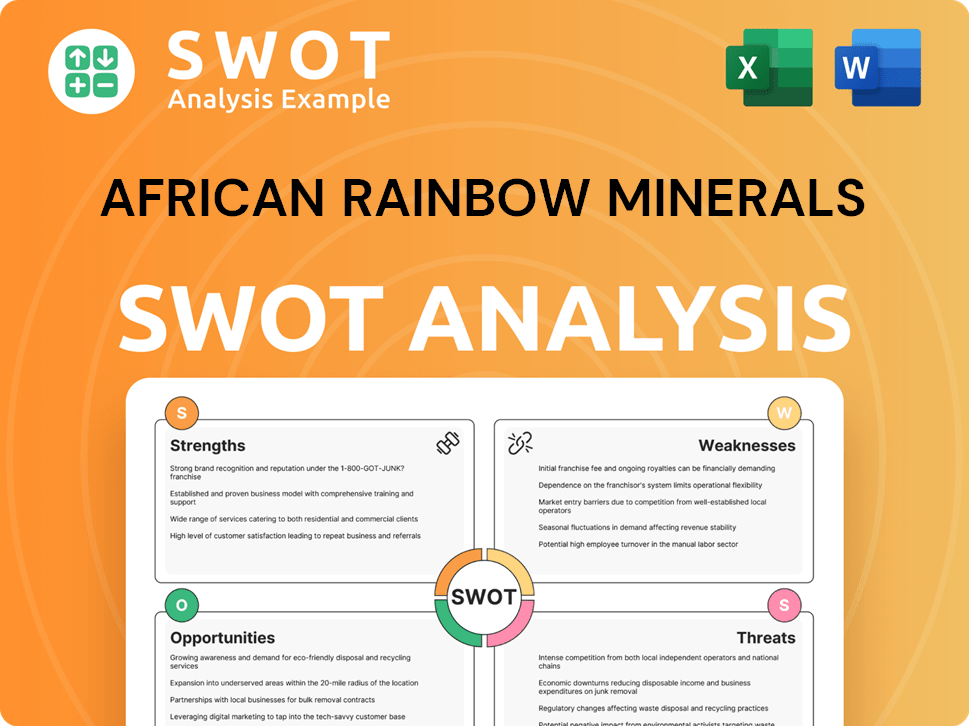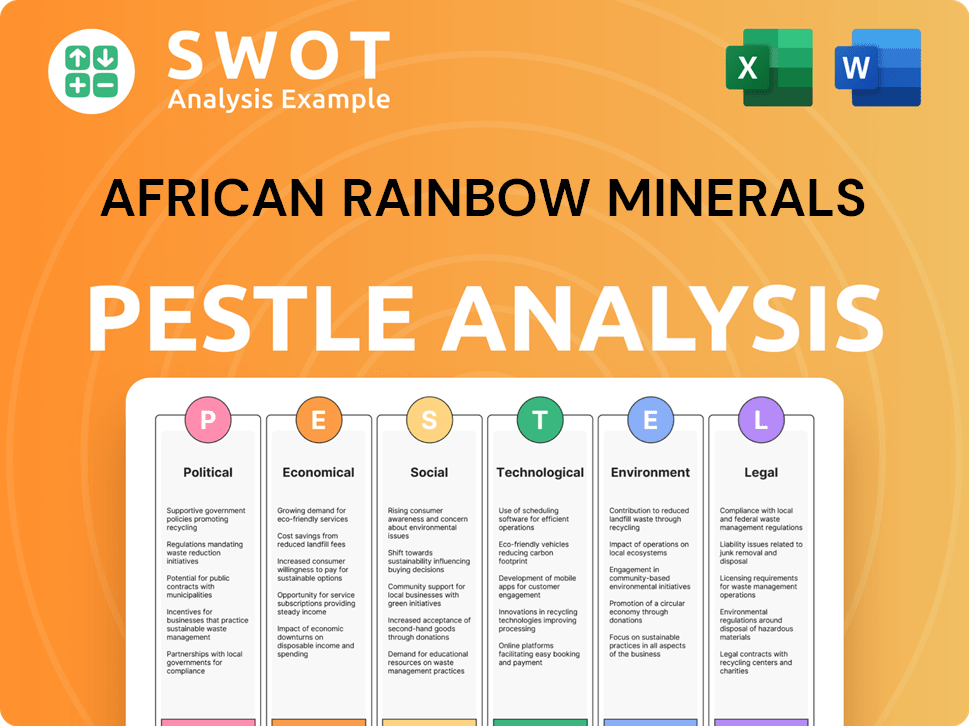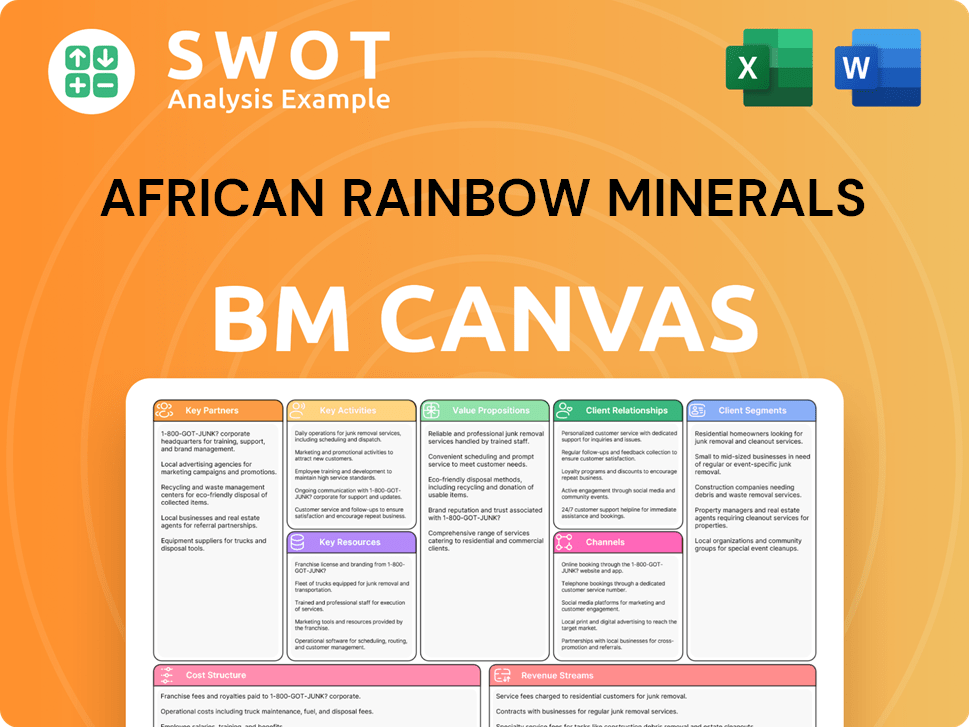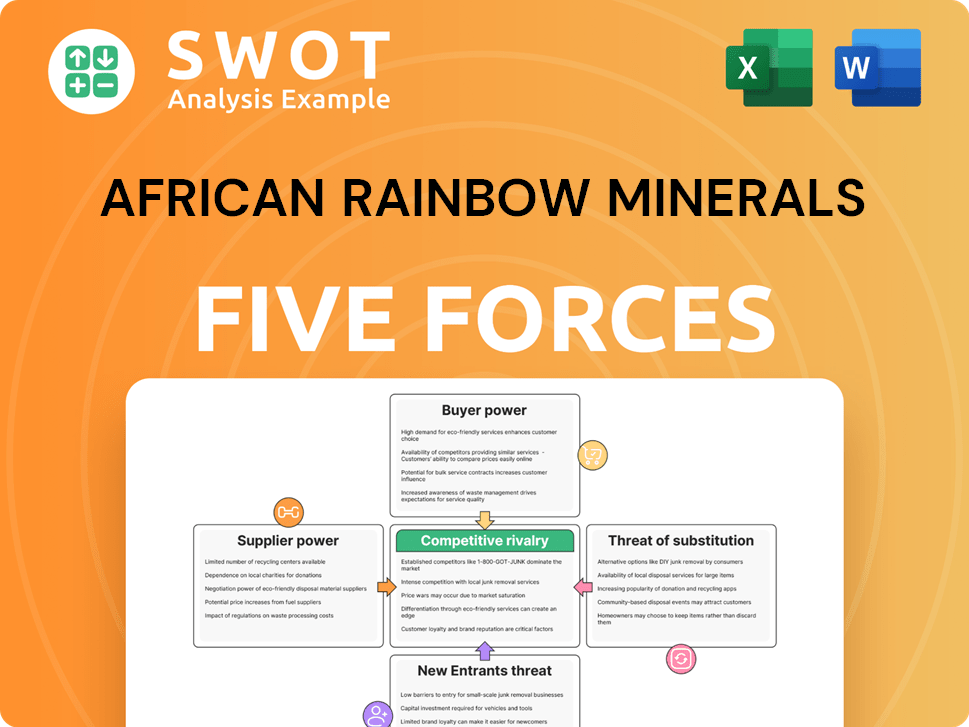African Rainbow Minerals Bundle
Who Really Owns African Rainbow Minerals?
Unraveling the ownership of African Rainbow Minerals (ARM) is key to understanding its strategic moves and future prospects. As a major player in South Africa's mining sector, ARM's ownership structure is a fascinating case study in Black economic empowerment and corporate governance. Understanding who controls ARM provides critical insight into its operational priorities.

Founded by the visionary Patrice Motsepe, the African Rainbow Minerals SWOT Analysis reveals the intricacies of its operations. The ARM company's journey, from its inception to its current status as a diversified mining giant, is deeply intertwined with its ownership dynamics. Exploring the ARM ownership structure offers a unique perspective on the company's resilience and its impact on the global mining landscape.
Who Founded African Rainbow Minerals?
The formation of African Rainbow Minerals (ARM) in 2004 marked a significant event in South Africa's mining sector. The company was co-founded by Patrice Motsepe, a prominent figure in South African business. Motsepe's vision was to create a globally competitive mining company that also championed Black economic empowerment (BEE).
Motsepe's role as co-founder was pivotal, building upon his earlier ventures in the mining industry. ARM's early ownership structure was specifically designed to reflect and promote BEE principles. This strategic approach ensured that a substantial portion of the company's ownership and control was held by historically disadvantaged South Africans, aligning with the government's broader economic transformation goals.
While precise initial equity splits and shareholding percentages for all early backers are not readily available in public records for the precise moment of ARM's 2004 formation from the merger of ARMgold and Harmony Gold's assets, Patrice Motsepe's direct and indirect control was foundational. The consolidation of various mining interests, including those previously held by Motsepe's ARMgold, played a crucial role in ARM's early development.
Patrice Motsepe co-founded ARM in 2004, driven by a vision to create a leading mining company. This vision included a strong emphasis on Black Economic Empowerment (BEE).
The early ownership structure of ARM was designed to promote BEE principles. This involved strategic partnerships and allocations to ensure significant ownership by historically disadvantaged South Africans.
Patrice Motsepe's direct and indirect control was foundational to ARM's early success. His influence was critical in shaping the company's direction and values.
ARM's formation involved consolidating various mining interests, including those from Motsepe's ARMgold. This consolidation was a key step in ARM's initial growth.
Early agreements likely included provisions to solidify BEE ownership and control. This aligned with the South African government's push for greater inclusivity in the economy.
The founding team's vision was reflected in a commitment to a diversified portfolio and local beneficiation. This underpinned a robust ownership structure aimed at long-term sustainability.
The initial structure of the ARM company was designed to reflect and promote Black Economic Empowerment (BEE) principles. This involved strategic partnerships and allocations to ensure that a significant portion of the company's ownership and control rested with historically disadvantaged South Africans. While the exact details of angel investors or early stakeholders are not widely publicized, the formation of African Rainbow Minerals involved consolidating various mining interests, including those previously held by Motsepe's ARMgold. Early agreements likely included provisions to solidify BEE ownership and control, aligning with the South African government's push for greater inclusivity in the economy. The founding team's vision was clearly reflected in the commitment to a diversified portfolio and a strong emphasis on local beneficiation and community development, all underpinned by a robust ownership structure aimed at long-term sustainability and empowerment. The commitment to BEE was a core principle from the beginning, shaping the company's identity and operations. As of 2024, Patrice Motsepe remains a key figure in the company, and the commitment to BEE continues to be a significant aspect of its corporate strategy. For more information about the company, you can read this article about African Rainbow Minerals.
ARM was co-founded by Patrice Motsepe in 2004.
- Motsepe's vision included creating a globally competitive mining company.
- Early ownership focused on Black Economic Empowerment (BEE).
- The structure aimed at long-term sustainability and community development.
- The consolidation of mining interests, including those from ARMgold, was crucial.
African Rainbow Minerals SWOT Analysis
- Complete SWOT Breakdown
- Fully Customizable
- Editable in Excel & Word
- Professional Formatting
- Investor-Ready Format

How Has African Rainbow Minerals’s Ownership Changed Over Time?
The ownership structure of African Rainbow Minerals (ARM) has evolved considerably since its establishment in 2004. As a publicly traded entity on the Johannesburg Stock Exchange (JSE), its ownership is shaped by a mix of institutional investors, mutual funds, and individual shareholders. The influence of Patrice Motsepe, through his investment vehicles, remains a key factor in ARM's ownership. African Rainbow Minerals and Exploration Investments (ARMI), which is ultimately controlled by Motsepe, holds a significant stake, ensuring his strategic vision continues to guide the company. For a deeper dive into the company's origins, consider reading the Brief History of African Rainbow Minerals.
Major institutional investors also hold a substantial portion of ARM's shares. These include large asset managers, pension funds, and investment firms that manage shares on behalf of their clients. While specific percentages fluctuate based on market dynamics, these institutional holdings often constitute a majority of the publicly traded shares. For example, in late 2024 and early 2025, significant institutional investors like the Public Investment Corporation (PIC), which manages South African government employee pension funds, are typically among the largest shareholders in major South African companies, including ARM. Various local and international investment funds seeking exposure to the diversified mining sector also represent notable stakeholders. Monitoring SEC filings (for any ADR listings) and annual reports provides the most current figures on major shareholdings, which can influence company strategy regarding capital allocation, expansion projects, and dividend policies. The combination of a significant founder stake and the oversight of large institutional investors contributes to ARM's governance framework.
| Year | Key Event | Impact on Ownership |
|---|---|---|
| 2004 | Formation of ARM | Initial ownership structure established, with Patrice Motsepe as a key founder. |
| Ongoing | Public Listing on JSE | Introduced institutional and individual shareholders, diversifying ownership. |
| 2024-2025 | Market Fluctuations and Investment Decisions | Ongoing shifts in institutional holdings and individual shareholder stakes, influencing the overall ownership structure. |
The stability provided by Patrice Motsepe's significant stake, combined with the oversight of large institutional investors, contributes to ARM's robust governance framework. This structure supports strategic decision-making and ensures accountability to a broad range of stakeholders. As of early 2025, the company continues to navigate the complexities of the mining industry, guided by its established ownership dynamics and strategic vision.
Patrice Motsepe remains a key figure in ARM's ownership through his investment vehicles, ensuring his strategic vision influences the company's direction. Major institutional investors, including pension funds and asset managers, hold a significant portion of the shares.
- ARM is a publicly listed company on the JSE.
- African Rainbow Minerals and Exploration Investments (ARMI) holds a substantial stake.
- Institutional investors often represent a majority of publicly traded shares.
- The governance framework benefits from a significant founder stake and institutional oversight.
African Rainbow Minerals PESTLE Analysis
- Covers All 6 PESTLE Categories
- No Research Needed – Save Hours of Work
- Built by Experts, Trusted by Consultants
- Instant Download, Ready to Use
- 100% Editable, Fully Customizable

Who Sits on African Rainbow Minerals’s Board?
The Board of Directors of African Rainbow Minerals (ARM) is pivotal in the company's governance, overseeing its strategic direction. As of early 2025, the board includes representatives associated with the founding ownership, particularly those linked to Patrice Motsepe's interests. Additionally, independent non-executive directors contribute external expertise, ensuring strong corporate governance. The Chairman of the Board, often Patrice Motsepe or an individual closely connected to his group, holds considerable influence due to the founder's significant ownership. This structure helps maintain a balance between shareholder interests and the company's strategic goals.
The composition of the board reflects ARM's commitment to its founding principles, including Black economic empowerment and sustainable mining practices. The presence of independent directors ensures that diverse perspectives are considered in decision-making processes. The board's role is crucial in navigating the complexities of the mining industry, particularly in South Africa, and in ensuring long-term value creation for all stakeholders. The board's decisions are critical to the company's operational efficiency and its ability to adapt to market changes.
| Board Member | Role | Affiliation |
|---|---|---|
| Patrice Motsepe | Chairman (Often) | Founder/Shareholder |
| Independent Directors | Non-Executive | Various |
| Executive Directors | CEO, CFO, etc. | ARM Management |
ARM operates under a one-share-one-vote structure, common for companies listed on the JSE. However, the substantial shareholding by entities controlled by Patrice Motsepe gives him considerable de facto voting power. Although there are no dual-class shares or special voting rights, the volume of shares held by the founder and related entities significantly influences key decisions. This structure ensures that the company's long-term vision, often aligned with its founding principles, remains central to its operations. For more information on the company's strategic direction, consider reading about the Growth Strategy of African Rainbow Minerals.
The board of directors at ARM is a mix of major shareholders and independent members, ensuring a balance of interests.
- Patrice Motsepe's influence is significant due to his substantial ownership.
- ARM uses a one-share-one-vote system, but ownership concentration affects voting power.
- The board's structure supports the company's long-term vision and strategic goals.
- Focus on Black economic empowerment and sustainable mining remains central.
African Rainbow Minerals Business Model Canvas
- Complete 9-Block Business Model Canvas
- Effortlessly Communicate Your Business Strategy
- Investor-Ready BMC Format
- 100% Editable and Customizable
- Clear and Structured Layout

What Recent Changes Have Shaped African Rainbow Minerals’s Ownership Landscape?
Over the past few years, the ownership structure of the ARM company has remained relatively stable, with a continued emphasis on institutional investment. While specific percentages fluctuate, large asset managers and pension funds have consistently held significant stakes, adjusting their positions based on market conditions and commodity price movements. The influence of global demand, particularly for minerals like platinum group metals and iron ore, has played a role in portfolio rebalancing by institutional investors. This dynamic subtly shifts the shareholding percentages among various entities.
The foundational ownership, primarily associated with Patrice Motsepe, has not undergone major changes. Furthermore, there have been no significant share buybacks or secondary offerings, indicating a focus on operational growth and dividend distribution rather than substantial capital structure alterations. Industry trends, such as the increasing focus of ESG-oriented investors, continue to influence the ownership landscape. ARM's commitment to sustainable growth and value creation for all shareholders reinforces the stability of its ownership base. For further insights into the company's strategic direction, consider reading about the Growth Strategy of African Rainbow Minerals.
| Metric | Data | Year |
|---|---|---|
| Market Capitalization (Approx.) | Around $4.5 billion USD | Early 2025 |
| Institutional Ownership (Approx.) | Typically above 50% | 2024-2025 |
| Revenue (Latest Annual Report) | Around $3 billion USD | 2024 |
ARM's focus on operational efficiency and strategic investments, such as those within Assmang, suggests a steady outlook for its ownership. The company's financial results and annual reports provide detailed insights into its performance and strategic direction, which in turn informs investor decisions and ownership trends.
The ownership structure of African Rainbow Minerals, or ARM, has remained relatively consistent, with Patrice Motsepe as a key figure. Institutional investors continue to hold significant stakes, adjusting their holdings based on market dynamics.
Commodity prices and global demand, particularly for platinum group metals and iron ore, influence portfolio adjustments by institutional investors. This can subtly change the percentage of shares held by various entities.
ARM prioritizes operational growth and dividend distribution over significant capital structure changes. The company's strategic investments and focus on sustainable growth indicate a stable ownership outlook.
Increased scrutiny from ESG-focused investors influences institutional holdings. ARM's commitment to sustainable growth and value creation aligns with these trends, reinforcing the stability of its ownership base.
African Rainbow Minerals Porter's Five Forces Analysis
- Covers All 5 Competitive Forces in Detail
- Structured for Consultants, Students, and Founders
- 100% Editable in Microsoft Word & Excel
- Instant Digital Download – Use Immediately
- Compatible with Mac & PC – Fully Unlocked

Related Blogs
- What are Mission Vision & Core Values of African Rainbow Minerals Company?
- What is Competitive Landscape of African Rainbow Minerals Company?
- What is Growth Strategy and Future Prospects of African Rainbow Minerals Company?
- How Does African Rainbow Minerals Company Work?
- What is Sales and Marketing Strategy of African Rainbow Minerals Company?
- What is Brief History of African Rainbow Minerals Company?
- What is Customer Demographics and Target Market of African Rainbow Minerals Company?
Disclaimer
All information, articles, and product details provided on this website are for general informational and educational purposes only. We do not claim any ownership over, nor do we intend to infringe upon, any trademarks, copyrights, logos, brand names, or other intellectual property mentioned or depicted on this site. Such intellectual property remains the property of its respective owners, and any references here are made solely for identification or informational purposes, without implying any affiliation, endorsement, or partnership.
We make no representations or warranties, express or implied, regarding the accuracy, completeness, or suitability of any content or products presented. Nothing on this website should be construed as legal, tax, investment, financial, medical, or other professional advice. In addition, no part of this site—including articles or product references—constitutes a solicitation, recommendation, endorsement, advertisement, or offer to buy or sell any securities, franchises, or other financial instruments, particularly in jurisdictions where such activity would be unlawful.
All content is of a general nature and may not address the specific circumstances of any individual or entity. It is not a substitute for professional advice or services. Any actions you take based on the information provided here are strictly at your own risk. You accept full responsibility for any decisions or outcomes arising from your use of this website and agree to release us from any liability in connection with your use of, or reliance upon, the content or products found herein.